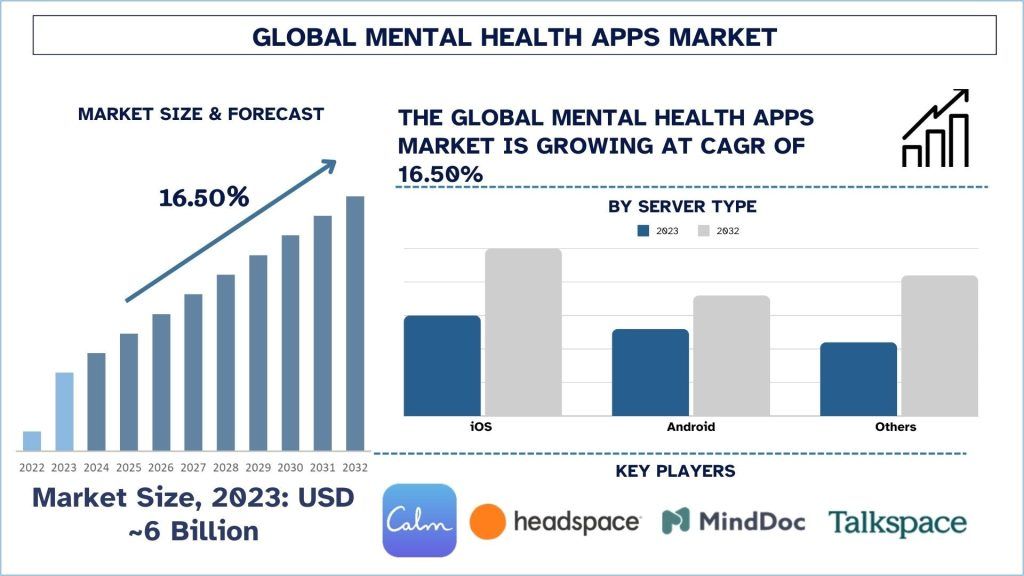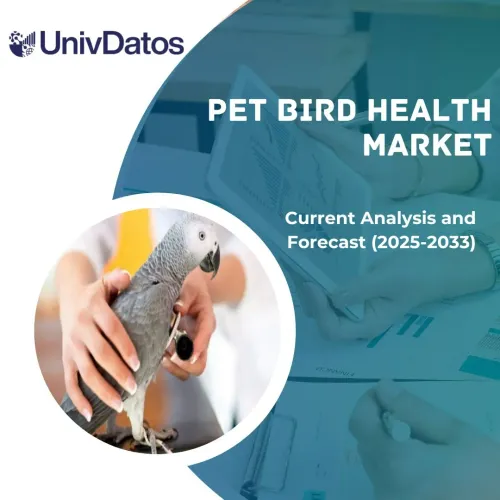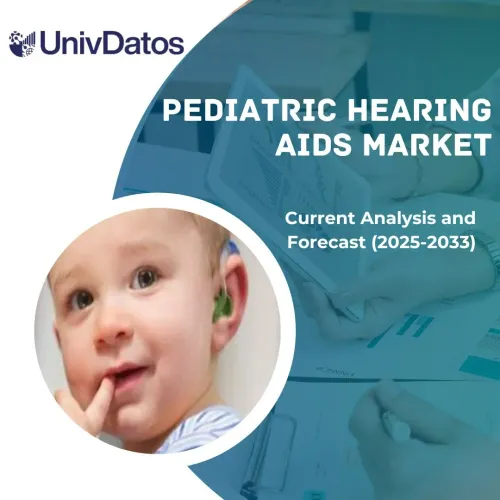- Home
- About Us
- Industry
- Services
- Reading
- Contact Us
Mental Health Apps Market: Current Analysis and Forecast (2024-2032)
Emphasis on Operating Systems (Android, iOS and Others); Payment Mode (Free Apps, Paid Apps); Subscription Model (Monthly, Yearly); Applications (Mental Disorder Apps, Substance-Use Disorder Apps, Co-Occurring Disorder Apps, Others) and Region & Country.
Mental Health Apps Market Size & Forecast
The Mental Health Apps Market was valued at approximately USD 6 Billion in 2023 and is expected to grow at a substantial CAGR of around 16.5% during the forecast period (2024-2032) owing to the increased internet penetration and widespread adoption of smartphones.
Mental Health Apps Market Analysis
Mental health apps are applications created to help users maintain and enhance their mind health. Such apps offer features like mood monitoring, guided meditation, therapy, CBT, and self-help among others. Some can be reached through mobile phones and this has made it easier for people who feel this way to get the help they need irrespective of the place they are stationed. The apps are typically developed to take on stress, anxiety, depression and other related disorders, and to provide help at that level, or in cases where required, to refer the user to a professional.
The growth of mental health apps is due to a rise in the demand for solutions for mental health problems, which in turn is because of awareness about such problems being felt across the world. As per the World Health Organization, in 2022, 1 in every 8 people in the world live with a mental disorder. Adding to this, the leaders of mental health app platforms try AI-driven individualization, incorporate teletherapy into their services, and actively develop cooperation with healthcare institutions to ensure growth. In April 2024, Fortis Healthcare introduced ‘Adayu Mindfulness,’ a new AI-driven application designed to help individuals dealing with mental health issues. They are concentrating on increasing customer loyalty by using analytics information, providing different subscription models, and the issue of data protection. Moreover, it has been identified to be successful in the growth strategy is the involvement of employers and insurers in sponsoring the mental health apps as part of the wellness programmers offered at the workplace, while expanding the pool of consumers and enhancing its access, respectively.
Mental Health Apps Market Trends
This section discusses the key market trends influencing the various segments of the Mental Health Apps market as identified by our research experts.
Anxiety Transforms Mental Health Apps Industry
As anxiety disorders are among the most prevalent mental health conditions in the world, the anxiety segment clearly contributes to the most to the market growth of mental health apps. As stress and anxiety disorders have become more common, beginning with the current lifestyle problems and further compounded by the COVID-19 outbreak, people also require practical and instant methods to alleviate these conditions. Mental health apps give a user an opportunity to undertake therapies such as CBT, mindfulness or stress management exercises for those experiencing anxiety. Moreover, these apps also pass features such as mood tracking at real time, breathing exercises, as well as continued support always, characteristics that is greatly valued by those who have anxiety. Increased consumer interest in personal wellness kits and the inclusion of anxiety applications as a part of organizational employee assistance programs have also pushed the segment forward and turned anxiety-centered mechanics into a growth driver for the entire industry.
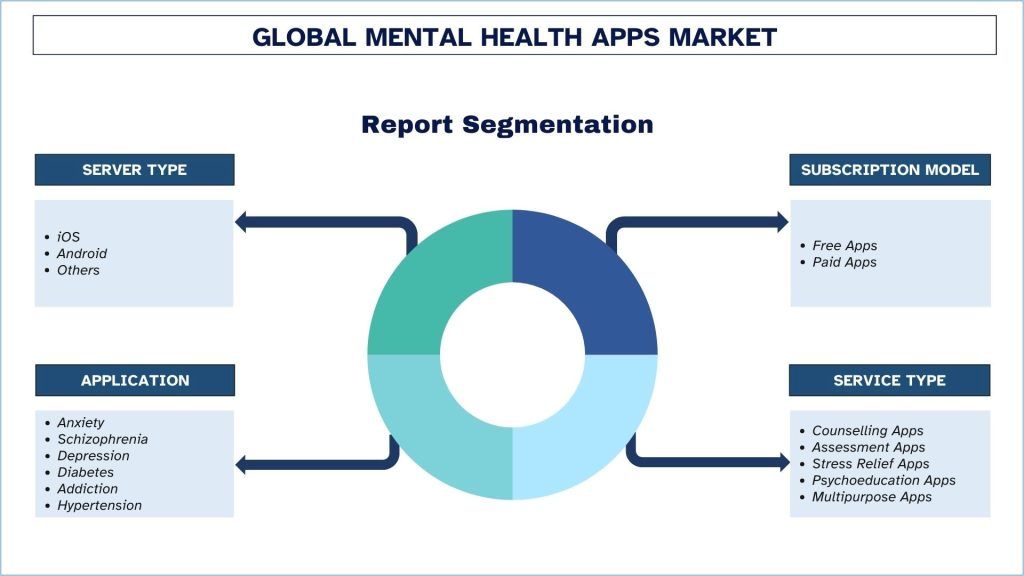
North America leads the market.
North America holds the largest share in the market for mental health apps. As per the NAMI.org, around 22.8% of U.S. adults experienced mental illness in 2021 (57.8 million people). This represents 1 in 5 adults. And around 47.2% of U.S. adults with mental illness received treatment in 2021. North America is one of the key contributors to the market for mental health apps because of the high rate of smartphone adoption, a continually rising concern for mental health, and rising interest in digital health solutions. The health system of the area is well developed, and the telehealth services adopted here are well accepted which led to the increased use of mental health apps. For instance, in October 2021, the United States Agency for International Development (USAID) and the Philippine Department of Health (DOH) launched Lusog-Isip – the country’s first mobile application for mental health and self-care. The enhancement in nowadays stress, anxiety, and depression in residents of the U.S. and especially young generations gives a driven demand to avail support tools for mental health.
Mental Health Apps Industry Overview
The Mental Health Apps market is competitive, with several global and international players. The key players are adopting different growth strategies to enhance their market presence, such as partnerships, agreements, collaborations, new product launches, geographical expansions, and mergers and acquisitions. Some of the major players operating in the market are Calm, Headspace Inc., MindDoc Health GmbH, Talkspace, Moodfit, Happify, Inc., BetterHelp, SonderMind Inc., NOCD Inc., Youper Inc.
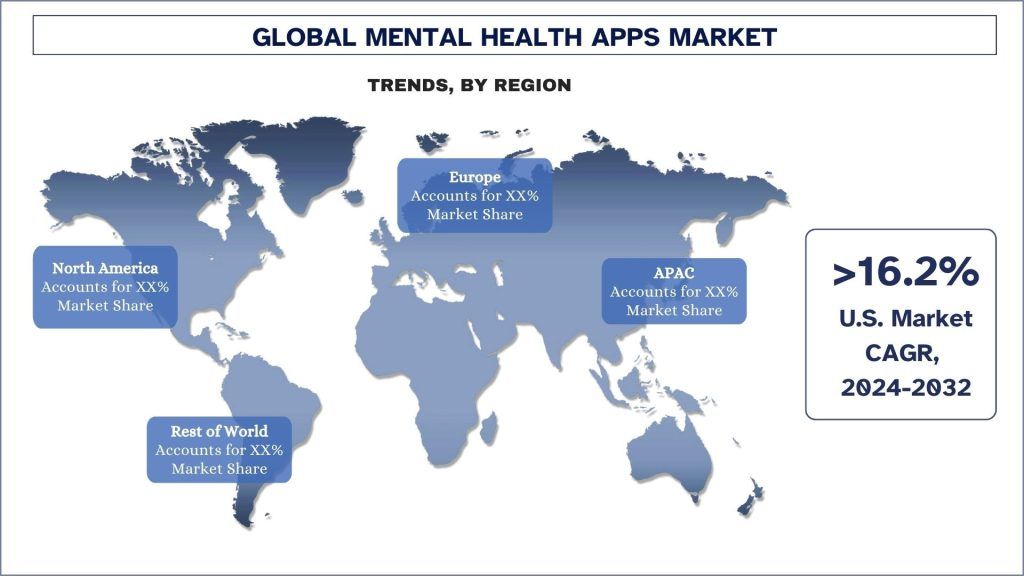
Mental Health Apps Market News
In July 2024, LiftNow, a mental health mobile app designed to support children’s emotional wellness, was officially launched in India this week at Vels Vidyashram CBSE School, Pallavaram, Tamil Nadu. The Vels schools have an enrolment of more than 30,000 students. Preethaa Ganesh, Vice President of the Vels Group of Institutions, and Amairha Pokala, Founder of LiftNow India, unveiled the app.
In June 2024, Talkspace, a leading online behavioral health care company, announced it will join forces with FitOn, the No. 1 fitness app and digital health and wellness platform, to provide a holistic mental health and fitness solution to employers, and showcase the power of bringing together physical and mental fitness into an everyday setting.
In October, 2022: Diageo, maker of Smirnoff, Gordon’s and Guinness, become the first global FMCG company launched Unmind mental health app available to all employees worldwide. Coinciding with World Mental Health Day, Diageo’s 27,000 employees can now access the Unmind app through mobile and desktop devices.
Mental Health Apps Market Report Coverage
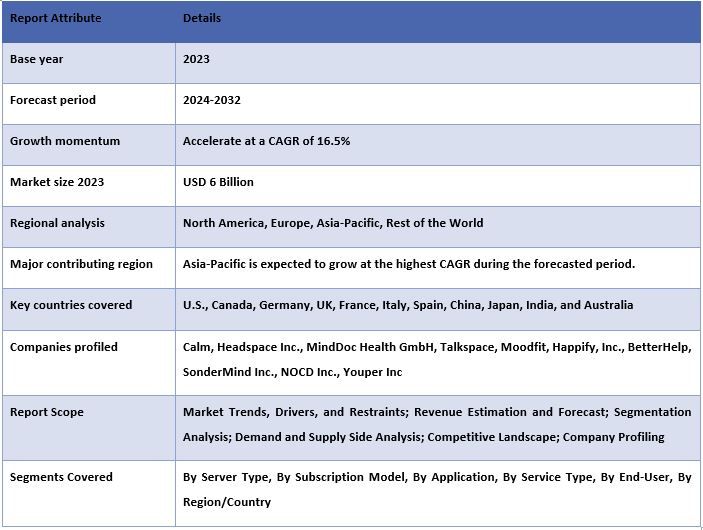
Reasons to buy this report:
- The study includes market sizing and forecasting analysis validated by authenticated key industry experts.
- The report presents a quick review of overall industry performance at one glance.
- The report covers an in-depth analysis of prominent industry peers with a primary focus on key business financials, product portfolios, expansion strategies, and recent developments.
- Detailed examination of drivers, restraints, key trends, and opportunities prevailing in the industry.
- The study comprehensively covers the market across different segments.
- Deep dive regional level analysis of the industry.
Customization Options:
The global Mental Health Apps market can be customized further as per the requirement or any other market segment. Besides this, UMI understands that you may have your own business needs, hence feel free to connect with us to get a report that completely suits your requirements.
Table of Content
Research Methodology for the Mental Health Apps Market Analysis (2022-2032)
Analyzing the historical market, estimating the current market, and forecasting the future market of the global Mental Health Apps market were the three major steps undertaken to create and analyze the adoption of Mental Health Apps in major regions globally. Exhaustive secondary research was conducted to collect the historical market numbers and estimate the current market size. Secondly, to validate these insights, numerous findings and assumptions were taken into consideration. Moreover, exhaustive primary interviews were also conducted, with industry experts across the value chain of the global Mental Health Apps market. Post assumption and validation of market numbers through primary interviews, we employed a top-down/bottom-up approach to forecasting the complete market size. Thereafter, market breakdown and data triangulation methods were adopted to estimate and analyze the market size of segments and sub-segments of the industry. Detailed methodology is explained below:
Analysis of Historical Market Size
Step 1: In-Depth Study of Secondary Sources:
A detailed secondary study was conducted to obtain the historical market size of the Mental Health Apps market through company internal sources such as annual reports & financial statements, performance presentations, press releases, etc., and external sources including journals, news & articles, government publications, competitor publications, sector reports, third-party database, and other credible publications.
Step 2: Market Segmentation:
After obtaining the historical market size of the Mental Health Apps market, we conducted a detailed secondary analysis to gather historical market insights and share for different segments & sub-segments for major regions. Major segments are included in the report as server type, subscription model, application, service type, end-user, and regions. Further country-level analyses were conducted to evaluate the overall adoption of testing models in that region.
Step 3: Factor Analysis:
After acquiring the historical market size of different segments and sub-segments, we conducted a detailed factor analysis to estimate the current market size of the Mental Health Apps market. Further, we conducted factor analysis using dependent and independent variables such as server type, subscription model, application, service type, end-user, and regions of the Mental Health Apps market. A thorough analysis was conducted for demand and supply-side scenarios considering top partnerships, mergers and acquisitions, business expansion, and product launches in the Mental Health Apps market sector across the globe.
Current Market Size Estimate & Forecast
Current Market Sizing: Based on actionable insights from the above 3 steps, we arrived at the current market size, key players in the global Mental Health Apps market, and market shares of the segments. All the required percentage shares split, and market breakdowns were determined using the above-mentioned secondary approach and were verified through primary interviews.
Estimation & Forecasting: For market estimation and forecast, weights were assigned to different factors including drivers & trends, restraints, and opportunities available for the stakeholders. After analyzing these factors, relevant forecasting techniques i.e., the top-down/bottom-up approach were applied to arrive at the market forecast for 2032 for different segments and sub-segments across the major markets globally. The research methodology adopted to estimate the market size encompasses:
- The industry’s market size, in terms of revenue (USD) and the adoption rate of the Mental Health Apps market across the major markets domestically
- All percentage shares, splits, and breakdowns of market segments and sub-segments
- Key players in the global Mental Health Apps market in terms of products offered. Also, the growth strategies adopted by these players to compete in the fast-growing market
Market Size and Share Validation
Primary Research: In-depth interviews were conducted with the Key Opinion Leaders (KOLs) including Top Level Executives (CXO/VPs, Sales Head, Marketing Head, Operational Head, Regional Head, Country Head, etc.) across major regions. Primary research findings were then summarized, and statistical analysis was performed to prove the stated hypothesis. Inputs from primary research were consolidated with secondary findings, hence turning information into actionable insights.
Split of Primary Participants in Different Regions

Market Engineering
The data triangulation technique was employed to complete the overall market estimation and to arrive at precise statistical numbers for each segment and sub-segment of the global Mental Health Apps market. Data was split into several segments and sub-segments after studying various parameters and trends in the server type, subscription model, application, service type, end-user, and regions of the global Mental Health Apps market.
The main objective of the Global Mental Health Apps Market Study
The current & future market trends of the global Mental Health Apps market were pinpointed in the study. Investors can gain strategic insights to base their discretion for investments on the qualitative and quantitative analysis performed in the study. Current and future market trends determined the overall attractiveness of the market at a regional level, providing a platform for the industrial participant to exploit the untapped market to benefit from a first-mover advantage. Other quantitative goals of the studies include:
- Analyze the current and forecast market size of the Mental Health Apps market in terms of value (USD). Also, analyze the current and forecast market size of different segments and sub-segments.
- Segments in the study include areas of the server type, subscription model, application, service type, end-user, and regions.
- Define and analyze the regulatory framework for the Mental Health Apps
- Analyze the value chain involved with the presence of various intermediaries, along with analyzing customer and competitor behaviors of the industry.
- Analyze the current and forecast market size of the Mental Health Apps market for the major region.
- Major countries of regions studied in the report include Asia Pacific, Europe, North America, and the Rest of the World
- Company profiles of the Mental Health Apps market and the growth strategies adopted by the market players to sustain the fast-growing market.
- Deep dive regional level analysis of the industry
Frequently Asked Questions FAQs
Q1: What is the mental health apps market's current size and growth potential?
Q2: What are the driving factors for the growth of the mental health apps market?
Q3: Which segment has the largest share of the mental health apps market by server type?
Q4: What are the major trends in the Mental Health Apps market?
Q5: Which region will dominate the Mental Health Apps market?
Related Reports
Customers who bought this item also bought

